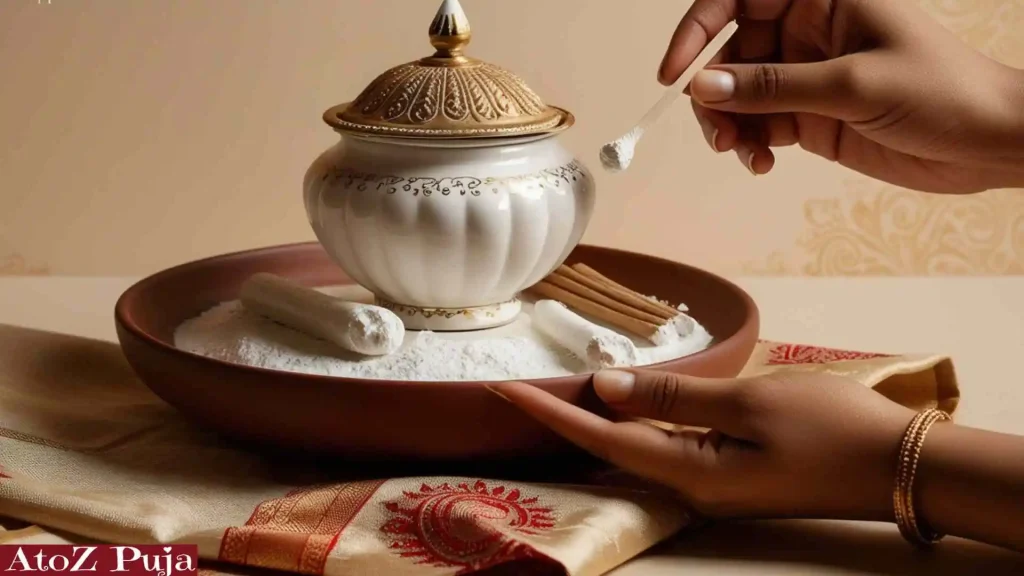South Indian White Tilak: The white tilak is a sacred mark on the forehead in South Indian traditions, symbolizing spiritual connection, inner peace, and divine blessings. Its rich history and rituals denote devotion, awakening of the mind’s potential, and bringing in good fortune in South Indian culture.
PUJA GUIDE AVAILABLE AT THIS PAGE
What is a Tilak?
The tilak is a symbol worn by Hindus in India and around the world. It is a sacred marking placed on the forehead between the eyebrows. This position is significant as it is near the ajna chakra, which is believed to be the seat of intuition and inner wisdom. The tilak’s material and design can vary, often made from sandwood paste, sacred ash, or colorful powders. It symbolizes an individual’s connection to the divine, serves as a reminder of their spiritual path, and represents auspiciousness and blessings.
Cultural Significance of the South Indian White Tilak

The white tilak in South Indian traditions holds symbolic and cultural significance, representing purity, peace, and spiritual connection. This sacred mark delves beyond aesthetics, with a rich history and ritualistic application that impacts the lives of devotees. Join us on a journey to explore its deeper meaning.
Religious Significance of the South Indian White Tilak
The white tilak, called vibhuti, is significant in Hinduism, especially in South India. It symbolizes purity of body, mind, and soul, and is linked to devotion to Lord Shiva. Vibhuti, derived from sacred fire, represents the transient nature of life and the importance of spiritual growth. It is often used to denote renunciation and detachment from worldly desires. Beyond symbolism, vibhuti is believed to provide protection and blessings, and is used in daily rituals to invoke divine presence and purify oneself before worship. In South Indian homes, applying vibhuti daily is a common practice that shows devotion and respect in Hindu culture.
Application and Preparation of South Indian White Tilak

The South Indian white tilak, also called vibhuti, is applied with care and consideration for its religious importance and is typically prepared and applied in a specific manner:
Preparation:
- Source of Vibhuti: Vibhuti is traditionally made from sacred materials such as dried cow dung or sacred ash derived from burnt cow dung, wood, or other organic substances. These materials are burned in a controlled environment to create the fine white ash known as vibhuti.
- Sacred Process: The preparation of vibhuti often involves rituals and prayers to sanctify the ash and imbue it with spiritual potency. In some cases, it may be consecrated by a priest or spiritual leader.
- Storage: Once prepared, vibhuti is stored in a clean and sacred container, such as a small metal or wooden box, reserved exclusively for its use. This container is kept in a clean and revered space, ensuring its purity.
Application:
- Cleanliness: Before applying vibhuti, one must ensure personal cleanliness. This includes washing hands and face, and wearing clean clothing.
- Invocation: Many devotees begin the application of vibhuti with a prayer or invocation to the divine, seeking blessings and purification.
- Gesture: Vibhuti is typically applied with the ring finger of the right hand. A small amount of vibhuti is taken from the container and placed on the forehead, between the eyebrows, where the third eye is believed to reside.
- Application Pattern: The vibhuti is often applied in three horizontal lines, representing the three aspects of existence – physical, mental, and spiritual. Alternatively, it may be applied in a circular pattern, symbolizing the eternal and cyclical nature of existence.
- Mantra: Some devotees recite a mantra or prayer while applying vibhuti, further enhancing its spiritual significance.
- Sharing: In some traditions, vibhuti is also shared with others as a form of blessing and goodwill. It may be applied to the foreheads of family members, friends, or fellow devotees during religious gatherings or ceremonies.
- Daily Practice: For many Hindus, applying vibhuti is part of their daily ritualistic worship (puja) or meditation practice. It is done with reverence and devotion, serving as a reminder of spiritual values and the presence of the divine in everyday life.
The application of South Indian white tilak, or vibhuti, is a sacred practice in Hinduism that is done with mindfulness and devotion to its religious significance.
Variations of the South Indian White Tilak

The South Indian white tilak, or vibhuti, is a canvas for various symbolic expressions and regional customs in its application. Traditionally, it consists of three horizontal lines on the forehead, symbolizing physical, mental, and spiritual aspects. There are also variations like vertical lines, triangle patterns, circles, or dots, each with its spiritual meanings. Custom designs and combinations with kumkum add to the tilak’s aesthetic and symbolic value. These variations reflect regional practices and allow for personal expression within Hindu traditions. Devotees can imbue their observances with personal meaning and creativity while respecting the sacred traditions of vibhuti application.
Tilak and its Effect on the Body
The application of tilak, specifically the white vibhuti in South India, is believed in Hindu tradition. Physically, the vibhuti’s ashes provide a cool feeling on the skin, especially during religious rituals. Its subtle scent creates a serene atmosphere conducive to spiritual practices. Symbolically, vibhuti’s purifying properties cleanse the body and mind, preparing devotees for spiritual engagement. Spiritually, applying vibhuti helps worshippers focus on divine contemplation, symbolizing a connection with Lord Shiva. It also represents devotion and commitment, serving as a visible symbol of faith within Hindu rituals. Overall, tilak, particularly vibhuti, goes beyond physical effects, offering devotees a way of expressing their spiritual devotion in Hindu traditions.
Conclusion:
The white tilak, specifically the revered South Indian vibhuti, is a sacred mark symbolizing spiritual connection, inner peace, and divine blessings in South Indian culture. It has a rich history and is ritually applied to denote devotion, awakening of the mind’s potential, and inviting good fortune. Physically, it provides coolness and purification, while spiritually it fosters focus, and connection with the divine, and serves as a visible symbol of faith in Hindu tradition. The tilak, particularly vibhuti, holds a significant place in Hindu culture, representing a timeless connection between the individual and the sacred.
FAQs:
Q: What is the significance of the white tilak in South Indian culture?
Ans: The white tilak, or vibhuti, symbolizes purity, peace, and spiritual connection in South Indian traditions.
Q: How is the white tilak applied and prepared?
Ans: Vibhuti is traditionally prepared from sacred materials like cow dung ash and applied on the forehead in patterns representing spiritual aspects of existence.
Q: What variations of the white tilak exist in South India?
Ans: Variations include three horizontal lines, vertical lines, triangular patterns, circles, and dots, each carrying nuanced symbolism and regional customs.
Q: What effects does the white tilak have on the body?
Ans: Physically, it offers a cooling sensation and subtle fragrance, while spiritually, it aids in focus, and connection with the divine, and serves as a visible symbol of devotion and faith.


